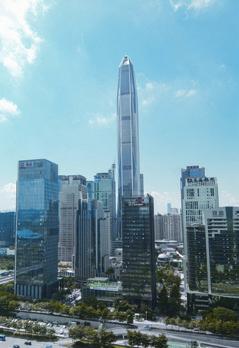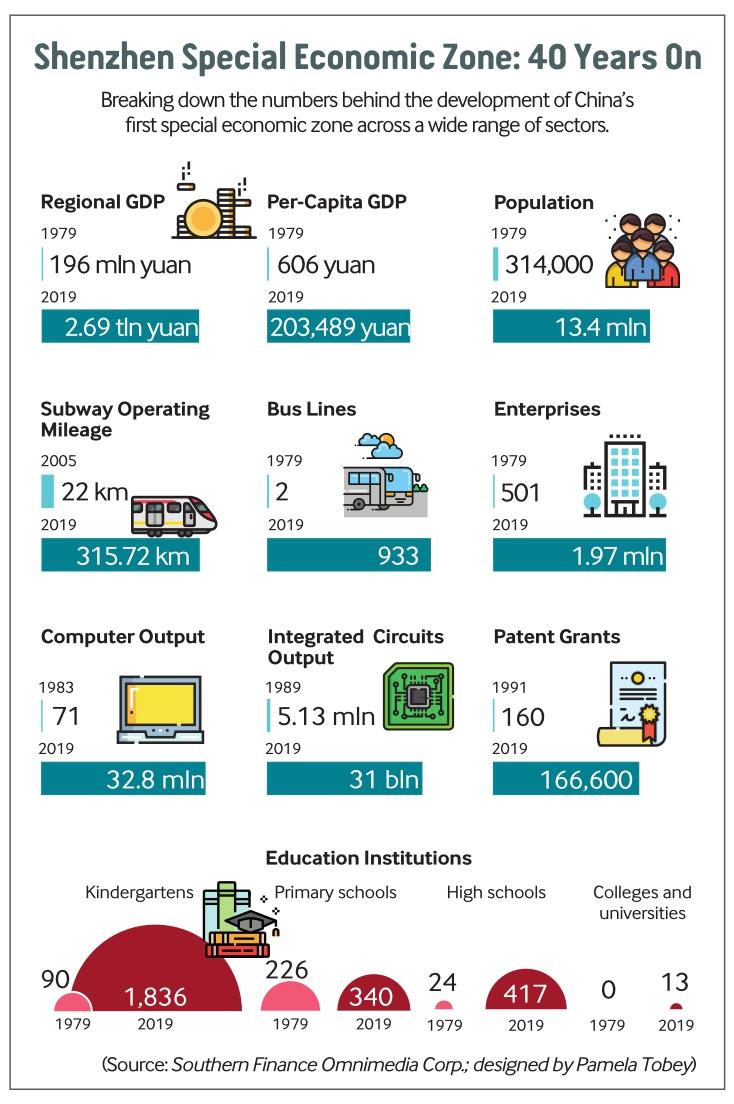A Special 40 Years
2020-09-16ByYuanYuan
By Yuan Yuan
Shenzhen in the southern province of Guangdong was born with special blood. Unlike many other cities that were naturally formed, it was created from barren land with the mission to spearhead Chinas development.
When the city was established on a backwater county in 1979, there were only 314,000 people. Now it has 13.4 million with people fl ocking from different parts of the country to this goldmine of reform and opening up.
One year after the citys establishment, Chinas first special economic zone (SEZ) was set up there, scooping up four of its six districts. Dubbed “the window of reform and opening up,”countless firsts in China took place in this wonderland, including the fi rst land auction, the fi rst stock issuance and the fi rst export-oriented industrial zone.
Today, Shenzhen is one of Chinas most developed first-tier cities along with Beijing, Shanghai and Guangzhou, capital of Guangdong, with a GDP skyrocketing from 196 million yuan ($133 million) in 1980 to 2.69 trillion yuan($394.8 billion) in 2019. Nearly 300 Fortune 500 enterprises have established regional headquarters, offi ces or research and development centers in the city.
A unique charm
Open is the keyword many use to describe the primary reason that they work and live in Shenzhen. Wu Haifeng, a researcher at the Shenzhen Finance Institute and the Chinese University of Hong Kong, and Li Xiaoting, Executive Director of C-Mer, a Hong Kong-based private eye care hospital, both agree.
“You never feel homesick in this city,” Wu said. “You dont have to worry if you are not fl uent in standard Mandarin or Cantonese because people speak many different dialects here and they dont care. They love sharing ideas, which makes you feel relevant right away.”

“It is a very young city, and so are its residents. When we were trying to choose our hospitals base on the Chinese mainland, Shanghai, Beijing and Guangzhou were also candidates, but Shenzhen beat them all out in the end,” Li said. The choice was due to Shenzhens proximity to Hong Kong and, more importantly, its welcoming market and preferable policies.
“The government of Shenzhen is very efficient,” Wu said. “It always thinks ahead and takes action to create a friendly environment for businesses. Starting a company may take a week in many other places, but in Shenzhen, it takes a couple of hours.”
He was echoed by Tao Yitao, Director of the China Center for Special Economic Zone Research at Shenzhen University. Tao attributed the rapid development of Shenzhen, and China as a whole, to breaking with existing practices.
When Shenzhen took the lead in exploring a market-led development pattern in 1980, the local government carried out a raft of policies pioneering the reform. In 1987, Ren Zhengfei founded Huawei in Shenzhen. Over the next more than four decades, the company has developed into a leading information and communications technology infrastructure and solutions provider in the world. Shenzhen is also the starting place and headquarters of several leading tech companies in China including Tencent and DJI, making it a renowned tech hub.
Team Concepts, a printing company in Hong Kong, has chosen Shenzhen as the base for expanding its business on Chinas mainland, Roger Yiu, founder of the company, said Shenzhen has a complete hardware supply chain. “If you are in the hardware business, you have to be in Shenzhen since it has made the whole process much easier,” Yiu said.“This is impossible in most other cities around the world.”
Wang Chuanfu, Chairman of BYD, said his companys evolution from a small battery maker to one of Chinas leading new-energy vehicle manufacturers is inseparable from Shenzhens unremitting efforts to push forward industrial upgrading.
Wang founded BYD in Shenzhen in 1995. Now it has obtained over 18,000 patents, with products sold in over 50 countries and regions. Such inspirational stories happen all the time in Shenzhen. “It is where business miracles are created,” Wang said.
On average, there are 8.5 state-level hi-tech enterprises per square km in Shenzhen, and an average of 71 invention patents authorized every day.
The fast growing industries have made scientific and technological professionals in great need and facilitated the development of education. In 1979, there were no colleges in Shenzhen at all and now it has 13 higher-learning institutions including Shenzhen University and Southern University of Science and Technology.
The leading engine
Shenzhen is playing an important role in developing the Greater Bay Area that comprises Hong Kong, Macao and nine cities in Guangdong.
In 2010, the central authorities decided to set up Qianhai SEZ in Shenzhen, aiming to strengthen the integration and cooperation between Shenzhen and Hong Kong. Air & Sea Logistics Far East North said it has benefited from the zones robust development in many ways.“We got closer to our business partners and customers in Qianhai SEZ since it has attracted many enterprises,” Kevin Chen, Managing Director of the company, said . “The growing number of hi-tech companies in Shenzhen requires highvalue-added transport solutions.”
On August 26, the Liantang Port/Heung Yuen Wai Boundary Control Point, the seventh land-based port at the Shenzhen-Hong Kong boundary, opened. It is also the first with direct access facilities for both passengers and vehicles. Located in the area planned for innovation and technology sectors, the new port is expected to offer fresh opportunities for hi-tech cooperation between Shenzhen and Hong Kong, a report by Xinhua News Agency quoted Liang Haiming, a Hong Kong-based economist, as saying.
In 2019, the Communist Party of China Central Committee and the State Council released a three-step program for building Shenzhen into a pilot demonstration area for socialism with Chinese characteristics. By 2025, Shenzhen will become one of the leading cities in the world in terms of economic strength and quality of development, according to the document. By 2035, it will become a national model of high-quality development, as well as a hub of innovation, entrepreneurship and creativity with international influence. By the middle of the century, it will be among the top cosmopolis in the world and serve as a global pacesetter with outstanding competitiveness, innovative capacity and infl uence.

For Dennis Lam, founder of C-Mer, this means more innovation for the development of Shenzhen. “Shenzhen will not only become a window for reform and opening up, but also a window to the world to show that good business can be done under a socialist system,” he said.
The city has prioritized sustainable development. Its air quality is the best among the four fi rst-tier cities. Dapeng New District, Shenzhens green development functional area on a peninsula with rich natural and marine resources, is exploring a new model of social and economic modernization for the city and the rest of China.
“Shenzhen has gained global attention for its historical opportunity in developing the first SEZ, a pilot demonstration area for socialism with Chinese characteristics and the Guangdong-Hong Kong-Macao Greater Bay Area,” Fan Gang, President of the China Development Institute, a Shenzhen-based think tank, said . “It should contribute more to Chinas governance with continuous innovation and also become a global benchmark city, contributing to the growth of the world economy.”
